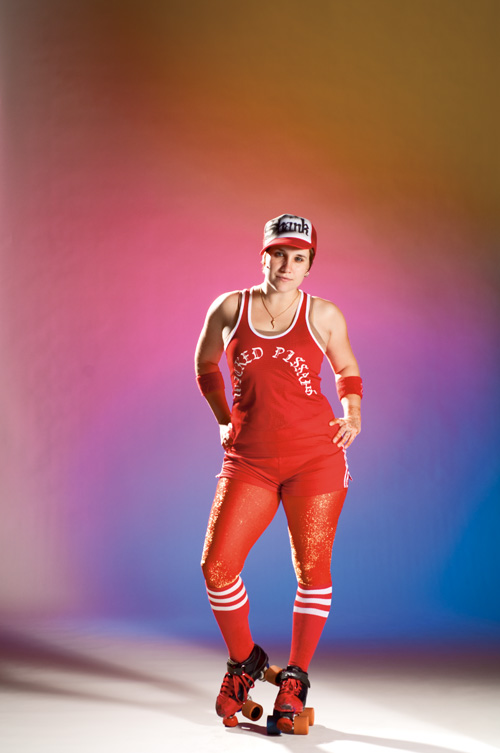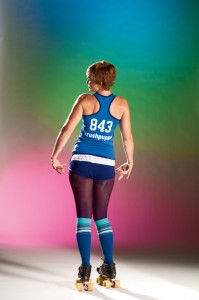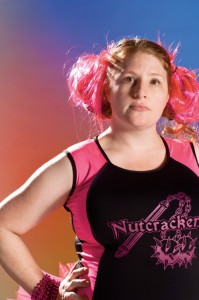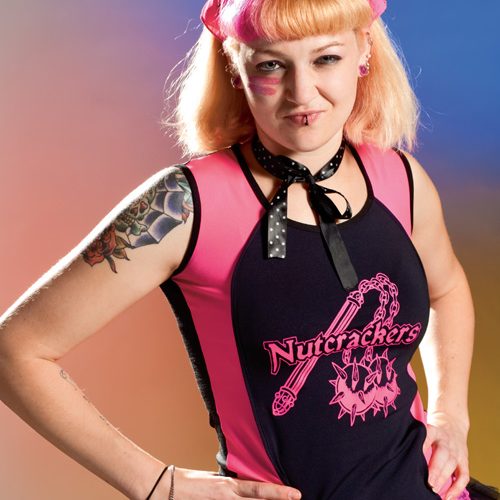Written by Bryon Rivers
Photographs by Tanit Sakakini
Tattoos, bruises, and big attitudes go with the territory but for these rollergirls, skating hard and staying off the concrete is only part of the game. This is roller derby like you’ve never seen before.
It’s a crisp fall Saturday night in Wilmington, and the parking outside Shriners Auditorium is beyond capacity, with vehicles spilling from designated lots onto both sides of Fordham Road. At the entrance, a handful of late arrivals form a line at the ticket window, while others talk on cell phones or grab a quick smoke before heading back inside. Â Once through the doors, a cursory look around is enough to inform newcomers that this is not a fair, antiques show, or any of the more pedestrian events for which the venue is known. As The Clash’s “London Calling” emanates loudly from the PA system, two groups of women (one in blue, the other red) wearing ’70s-style running shorts, matching baby-doll T-shirts and tanks, fishnet stockings, and roller skates, circle an oval track carefully fashioned from strips of neon pink duct tape. Â As alluring as they may look, the ladies (or “rollergirls,” as they prefer to be called) aren’t here to show off their outfits or flaunt their figures-they have come to do battle. A battle that will leave them bruised, battered, sweaty, exhausted, and smiling from ear to ear. Welcome to roller derby.
“For me, it’s one big adrenaline rush,” says Jenna Catanzano, a 25-year-old Haverhill resident who plays for the blue team-the Cosmonaughties-which, according to the team’s website, are “Soviet cyborgs” from outer space. “It’s like the best thing that’s ever happened to me. From the second I’m up on a bout [game] day, it’s like Christmas morning.”
Back on the rink, where Catanzano is better known by her derby name, Jennasaurus Wrecks, a referee’s whistle blows and skate wheels click and hiss across the track. The jam is on. Skaters in the front (pivots and blockers) form a pack, a moving wall of sorts, while those in the back (jammers) do their best to skate around, through, under, or over opponents and teammates in an effort to score points. It’s no easy task, as blockers take it upon themselves to thwart scoring passes by checking and corralling opposing jammers off course, out of bounds, or directly onto the cold, hard concrete.
Bodies collide, and knee and elbow pads are employed to soften the impact, as three skaters in the middle of the crowd get tangled up and hit the deck. Ten rows from the action is Dan MacDonald, a native Methuenite with a four-inch Mohawk, who cheers as a skater known as Ivanna Shankabitch  offers her shoulder to an opponent, who winds up flat her back.
 “I like the brutality,” says MacDonald, 24. “It’s a fun night out.” And he’s far from alone. More than 1,000 fans fill the stands, cheering on their favorite team or player as they streak past.
“I like the brutality,” says MacDonald, 24. “It’s a fun night out.” And he’s far from alone. More than 1,000 fans fill the stands, cheering on their favorite team or player as they streak past.
For those who haven’t experienced roller derby, this down-and-dirty little tale (or one much like it) is played out at least once a month from February to October, right here in our own backyard. Individuals old enough to recall teams such as the LA Thunderbirds, which terrorized TV screens on the 1960s program “Roller Games,” will find absent the theatrics and pummeling of yesteryear. Today’s game is far more about athleticism, strategy, and teamwork than sending opponents to the emergency room. But just like its predecessor, it’s hard-hitting, irreverent, fun, fast, and entertaining as only a sport played on roller skates and set to a punk rock soundtrack could be, especially when you factor in the colorful tattoos, color commentators, teams with names like The Wicked Pissahs, and players who go by Miss Mary Smack, Floral Derangement, and Killary Clinton.
Quirky nicknames, still as ingrained in the sport as hip checks, are carefully chosen. Each potential handle must be cleared via national registry (found online at twoevils.org/rollergirls), which contains thousands of already-spoken-for alter egos. No two names can be alike, or even overtly similar, according to the rules of the registry, in order to ensure that skaters do not “appropriate the names of (other) hard-working skaters who are trying their best to make roller derby a success.” Creativity is the name of the “name game,” and players go for everything from cute (Quick Sandy) to menacing (Assault n’ Flattery) to slightly naughty (Holly Nass) to R-rated (look it up yourself).
Carol Cunningham, 31, of Essex, who answers to Shellby Shattered when her skates are laced, pilfered her rollergirl name from the “Garbage Pail Kids” trading cards she collected as a grade school student. “Her name was Shattered Shelby and I just swapped it around. It’s supposed to be somewhat of a play on ‘she’ll be shattered,'” Cunningham says.
Collectively, Shellby and the rest of her amusingly-monikered skatemates are known as the Boston Derby Dames, an official member-league of the Women’s Flat Track Derby Association (the WFTDA is the official governing body for roller derby in the United States). The Dames’ 50-plus skaters make up five teams: The Nutcrackers, Cosmonaughties, and Wicked Pissahs, which compete for interleague titles, and the Boston B Party and the nationally ranked Boston Massacre, which are traveling teams.
Although the league is technically headquartered in Boston, Dames hail from towns all over eastern Massachusetts (with many calling the North Shore home) and hold practices and bouts in places like Saugus, Bradford, and Wilmington. And while you won’t find them on ESPN, NESN, or any other network, they sure can draw a crowd.
In 2008, an early-season bout broke a Shriners Auditorium attendance record, with 1,600-plus fans filling the stands, and in 2009, crowds of 1,400 or more were consistent throughout the season. For those who just can’t miss a match but also can’t afford to follow teams when they travel out of state, bouts are broadcast live on derbynewsnetwork.com.
Cunningham describes roller derby fans as “crazy in an awesome way,” and says they have fans who come to the bouts because they’ve worn thin on watching the Red Sox, Patriots, and Bruins. “It feels like any other Boston sports event when you come to our bouts. People get into it.”
“I’d rather watch this than go to a football game,” says Bob Bartlett, 51, of Haverhill, who met a couple of Derby Dames at a car show and decided to bring his family to a bout. “The girls who come in here are tough. I like to see that. It’s great to see women who are independent and tough. I raised my daughters to be like that.” Nick Ceruolo, 20, of North Andover, first discovered the Dames when he found a flyer while riding the bus, and he became an instant fan after his first bout. “Anyone can enjoy it,” says Ceruolo. “The girls are attractive, and it’s a lot of fun to watch. It seems like they get the crowd really involved in the sport.”
When it comes to shapes and sizes, derby girls truly run the gamut, according to Carroll Cunningham, a 31-year-old member of the Boston Massacre from Essex. “It’s a sport any woman, any age, any size can do, and I think that’s really appealing to women,” says Cunningham. Revere resident Shannon Baz-Casper, 30 (who plays for both the Nutcrackers and Massacre under the name Kitty Twister), agrees. “You don’t have to be an athlete to play derby, but derby will definitely turn you into one!”
Although it’s her first time attending a bout, Erin Joyce, 25, of Saugus, is ready to roll. “I want to try out,” she says. “It’s kind of hard core, and it looks like a lot of fun.” Joyce’s excitement represents a wave of popularity that has seen derby rise from the ashes in nearly every state in the country, as well as internationally. The Derby Dames is but one of more than 400 leagues-that’s leagues, not teams-that have formed around the globe since 2001. That number includes organizations as large and established as the Gotham Girls of New York and as small as the fledgling Skate Free or Die, which calls Manchester, New Hampshire, home.
 Cunningham has been with the Dames almost since day one, when it was one of just 20 or so teams in the WFTDA, and is incredulous at the growth. “At the end of the day, you’re like, ‘Look how far we’ve come with this sport!'” she says.
Cunningham has been with the Dames almost since day one, when it was one of just 20 or so teams in the WFTDA, and is incredulous at the growth. “At the end of the day, you’re like, ‘Look how far we’ve come with this sport!'” she says.
Credited with firing the initial shot (or blowing the first whistle, if you will) of the derby revolution is a small group of women in Austin, Texas, which in 2001 formed the first-of-its-kind DIY organization-Bad Girl, Good Woman (BGGW) Productions (now known as Texas Rollergirls)-and revived a sport that had all but hung up its helmet in the mid ’70s. Hell On Wheels, a documentary about BGGW, was released in 2007 and garnered nods and awards from independent film festivals across the globe.
Not to be outdone, Hollywood (more specifically, Drew Barrymore) brought rollergirls to the big screen in October with Whip It, the story of a young woman (played by Ellen Page of Juno fame) from Bodeen, Texas, who rejects a life of smalltime beauty pageants and the admonishments of her overbearing mother to join a derby team from Austin known as the Hurl Scouts. (Sound familiar?) While the film depicts a cartoonish level of violence that hasn’t been prevalent since the “Roller Games” days, when bouts were staged in the manner befitting “professional” wrestling, what it seems to get right is the level of camaraderie and acceptance that is prevalent in the roller derby of 2009.
One example of this is the “after-party.” Following every home bout, the Dames host a gathering for families, friends, fans, and yes, the competition, in the Fez Room at Shriners. So while two girls may be putting the hurt on each other when the game clock is running, odds are they’ll be clinking glasses and celebrating together in the hours that follow.
And just as Page’s character in Whip It is welcomed into the fold of the tattooed and tough-as-nails Hurl Scouts, women from all backgrounds and walks of life are encouraged to strap wheels on their heels here in New England. The Dames boast teachers, project managers, moms, and students.
“Even people who come in and are really timid or shy, their derby persona can take them out of that,” says Cunningham. “They can be whoever they want to be. You almost have to tap into a different personality. It’s such an aggressive sport. You get to be a little crazy. One of the great things is we will take anyone. That’s the unwritten open-arms policy of derby.” Baz-Casper says it’s also a great outlet for stress and agression. “Especially where it’s still often considered inexcusable or unfeminine for women to show such aggression,” she says. “It is extremely empowering to maintain a strong sense of femininity while playing a sport that requires such competitiveness and strength.”
 But while “open arms” are good, “broken arms” are not, so to limit the tally of wrecked rollergirls, all new recruits must go through a “Fresh Meat” training if they wish to become a Derby Dame. One of the most important skills to learn? Falling.
But while “open arms” are good, “broken arms” are not, so to limit the tally of wrecked rollergirls, all new recruits must go through a “Fresh Meat” training if they wish to become a Derby Dame. One of the most important skills to learn? Falling.
“No matter how good you are you’re going to fall a lot,” says Sarah Murray (a.k.a. the aforementioned Ivanna Shankabitch, Shank for short). “As a league, we need to be careful because girls need to realize what they are getting into.” Murray, a rookie and the youngest of the Dames at 24, recalled that her mother, now one of Shank’s biggest fans, wasn’t initially thrilled with the idea of her daughter becoming a rollergirl. “She thought I was going to get my faced bashed in and my teeth knocked out,” says Murray. “She was used to the derby of the ’60s and ’70s. Now it’s more of a sport. I assured her that no one was going to deck me in the face, at least not on purpose.”
Murray has managed to avoid anything worse than a sore shoulder, but that doesn’t mean something more serious is out of the question. Contact and impact, both with opponents and the track, are part of the game, and it does result in the occasional trip to the hospital or physical therapy.
“At times it can be really tough on your body,” says Catanzano. “I have two bad knees, broke my tailbone; my body is kind of achy all the time. It’s a very physical sport. They train you how to fall and how to take a hit, but you still get hurt.”
As taxing as it can be on the body, Catanzano says the biggest demand is time. Â Modern day derby is a do-it-yourself operation-typically owned, operated, driven, and supported by players. Besides bouts and 10-plus hours a week of practice, there are social engagements, appearances, and “derby jobs.” Every player is required to perform an administrative task to promote the team, the league, and the sport as a whole. Some post flyers or handle PR, while others man merchandise tables at events, book bands for the “halftime show,” or coordinate with one of several charities the Dames support. All told, it’s a 20- to 30-hour per week commitment. Much more than a sport, it’s a lifestyle.
As to whether her derby dedication is worth the sacrifice, Cunningham says that while the competition in the game itself is enough to keep it exciting, it’s the relationships that keep her coming back.
“There’s always going to be this thing that keeps us together,” she explains. “It’s like a family at this point.”
Catanzano agrees. “It’s really empowering to know that you’re all there for the same reason, for the love of the sport and hitting. Â Don’t get me wrong-I like that too.”

